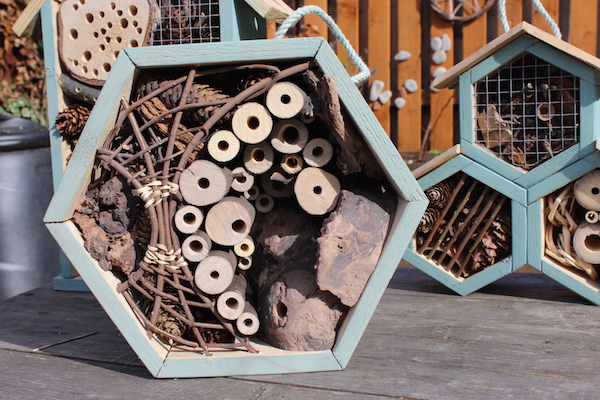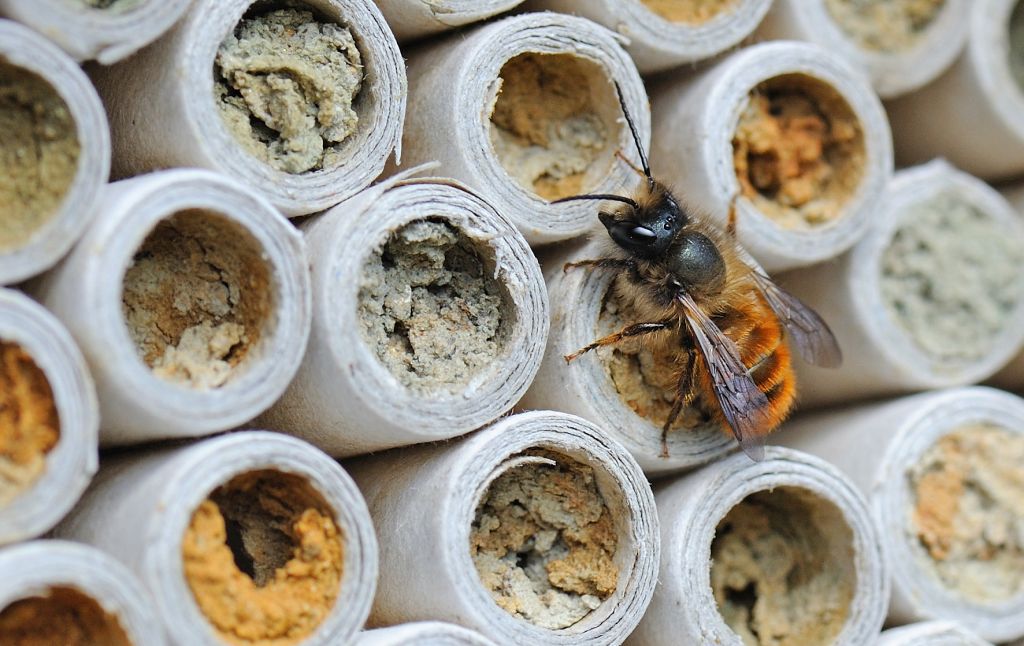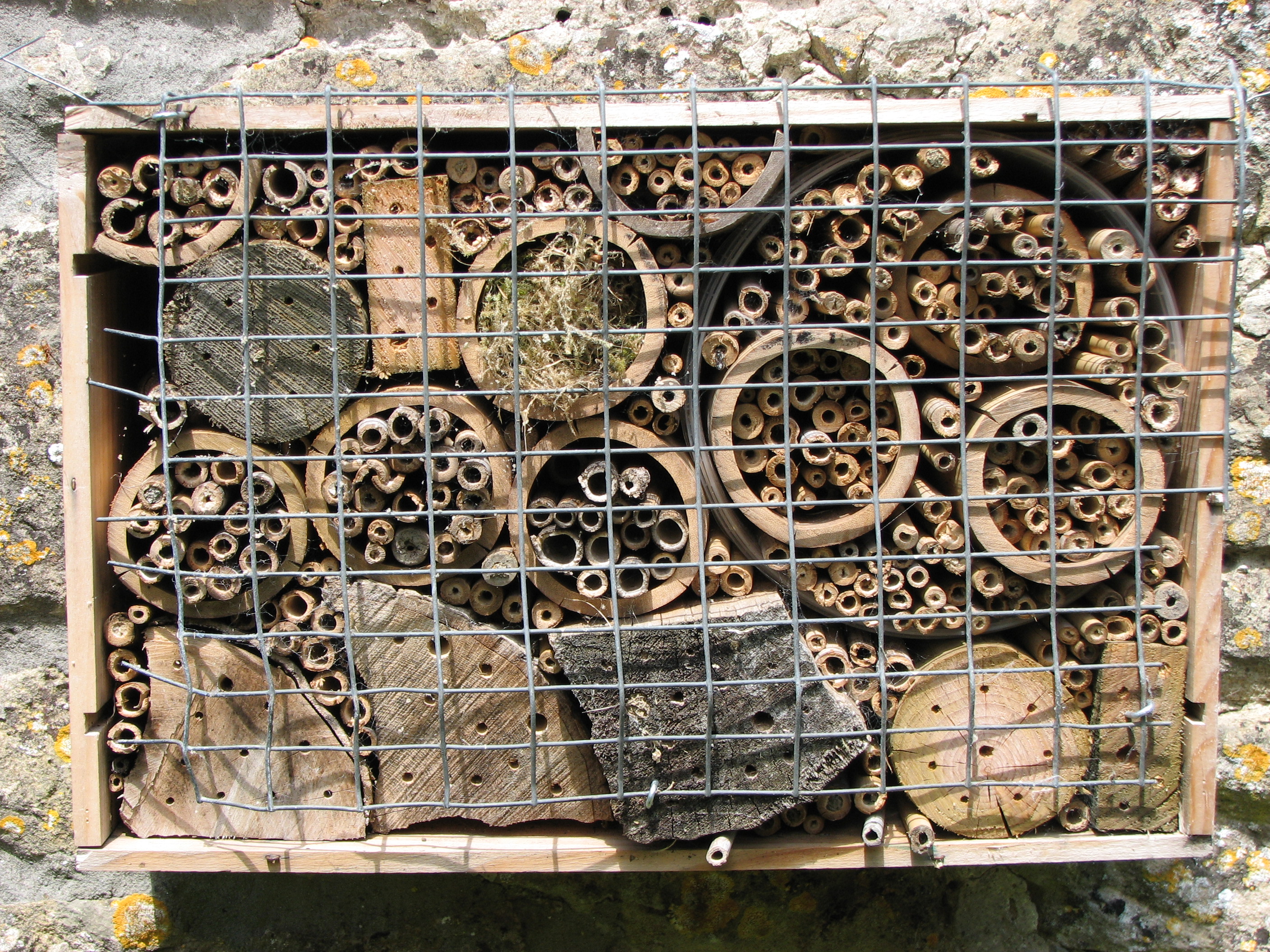Bee hotels are a great way to help our solitary bees, as much of their natural habitat has been built on or destroyed. As their name suggests, these bees don’t live in colonies, unlike bumblebees and honey bees.
Photograph by Tom Hansen
Solitary bees, such as mining bees, flower bees, leafcutter bees and mason bees, account for just under 250 of an estimated 275 British species, alongside 26 bumblebees and 1 species of honey bee. They are called 'solitary bees' because they make individual nest cells for their larvae. Many solitary bees are very small and you may not have realised they are bees. Solitary bees are harmless, they rarely if ever sting unless trodden on or squashed between your fingers. They do not have painful stings like honeybees. In most cases, you wouldn't even feel it.
Bee hotels are great for providing much needed shelter to some of these species that have lost their natural habitats. Mason bees, for example, traditionally would have made nests in soft cliffs and riverbanks, but most of these areas have now been grassed or concreted over.
Photograph by Marta Zientek and Wojciech
How to Build a Simple DIY Bee Hotel - You will need
• Small logs or pieces of wood
• A selection of plant stems (eg bamboo and sunflower stems)
• Sandpaper
• A drill, saw, nails and wooden drill bits
• Dry florists’ foam (optional)
• An untreated wooden box (re-cycled or waste wood and logs. Do not use solvent-based wood treatment products as these have a strong odour which could deter bees)
• Pencils
• A rustproof bracket
•Sticky tape
Photograph by Katherine Winter
Instructions
1. Using a saw, cut the small logs, wood and stems to fit box. Smooth sharp edges with sandpaper. Drill holes in the wood (a variety of solitary bees will use these tunnels as nest sites)
2. Arrange the wood, stems and foam in the box (open ends of these holes should face outwards)
2. Once you’re happy with the arrangement, make holes in the foam using a pencil or a selection of different-sized pencils. Don’t make the holes too big; the bees will happily excavate their own.
4. Using the bracket, fix the box to a wall or fence in the sunniest part of the garden. You may wish to grow flowers, such as roses or wisteria, near the box, to advertise it to leafcutter bees, but make sure plants don’t hide the box.
Photograph by Katherine Winter
Location, location, location - where to put your bee hotel
The location of your bee hotel is crucial. The bee house must be positioned in full sun, facing south east or south, at least a metre off the ground, with no vegetation in front of it obscuring the entrances to the tunnels. Solitary bees are cold-blooded and rely on the sun's heat to warm them up in the morning, hence the need for a sunny site.
The ideal height for a bee hotel is between 1 and 1.5 m off the ground. This will allow you to observe the nests and clean out any tubes that are clogged up.
Solitary bees have relatively short flying ranges of just a few hundred metres so they can’t go foraging very far. You therefore need to ensure there are plenty of flowers around your bee hotels.
This is so your residents have access to a top-quality supply of nectar and pollen. These can include a variety of plants, shrubs, herbs, garden flowers, fruit and vegetables which provide pollen and nectar rich flowers throughout the year.
Managing your Bee Hotel
Once you have made a bee house, it's very important that you continue to maintain it throughout the year.
Identify at the end of the summer any cells that remain in a walled-up condition from the previous year because no young bees emerged. The contents of these cells will be dead and should be removed and destroyed.
Identify any cells which have been taken over by the fly Cacoxenus indigator, whose larvae eat the pollen store and bee larvae. The contents of these cells should be removed and destroyed before the adult flies emerge.
Replace drilled blocks with brand new ones every two years. This is done in the summer, after the young bees have emerged. It will help to prevent the build-up of fungus moulds, mites and other pests and parasites.
Photograph by Dragonfli
And finally, beware of birds...
If you notice Woodpeckers or other birds attacking the tunnels looking for bee larvae, fix a piece of chicken wire across the front of the bee house. This does not seem to deter the bees.
Photograph from Habitat Aid
Sources: http://www.foxleas.com/make-a-bee-hotel.asp
http://www.telegraph.co.uk/gardening/beekeeping/10401683/How-to-make-a-solitary-bee-hotel.html?fb












